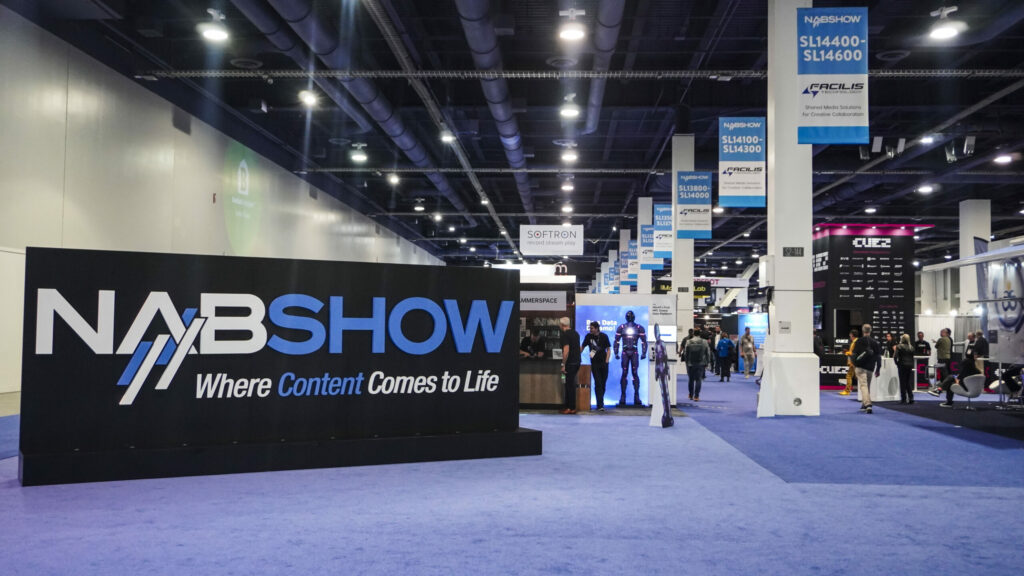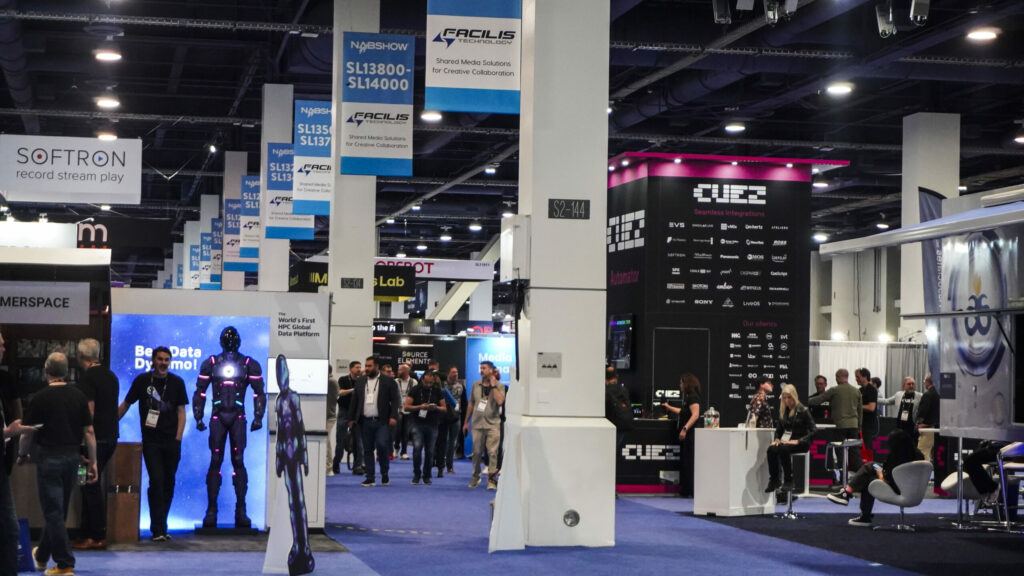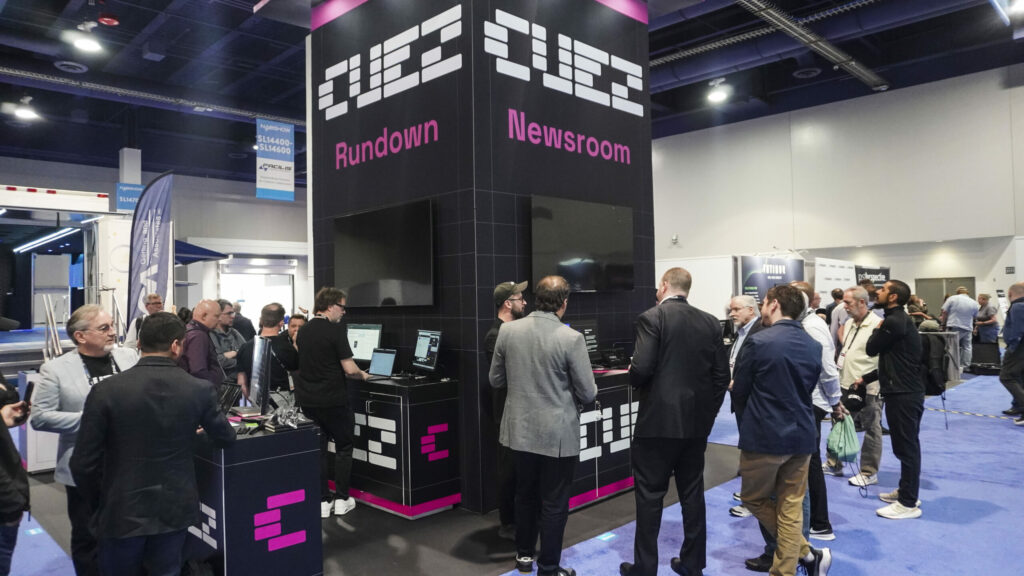NAB Show 2025 in Las Vegas has come to an end, and what a journey it has been for Cuez. Not only have we demoed our publish-point-centric newsroom solution, Storiez, cloud-based rundown and Automator, but we also jumped on the bandwagon of the latest tech and media industry trends. And let us tell you, those are quite impressive. Although NAB felt more North America-oriented, with fewer European and Latin American visitors, the quality of conversations was high, with key decision-makers, innovators, and change agents present, and that makes all the difference.
But what are the latest transformative trends shaping the future of media, and what can we expect in the near future?

Broadcasting reimagined
Is broadcasting dead? Well, not quite. It is evolving in ways a few could have predicted. The traditional idea of “broadcasting” as linear, scheduled, and one-size-fits-all is disappearing. That means that today broadcasters produce content not just for TV but also for social media, websites, digital news desks, YouTube, and such. In other words, traditional broadcasters are slowly becoming full-scale media houses.
The effects of this transformation were also noticeable at this year’s NAB. We see many new players, such as professional audiovisual and corporate customers, enter the scene, while fewer visitors from what would fit the “traditional broadcasters” mould. What used to be dominated by said broadcasters now feels more like a media technology showcase. At the age of consumer-led content creation, this is not surprising. Broadcasters are simply adapting to the natural evolution of the industry to meet their audiences wherever they are and deliver new types of content that viewers will want to consume.
AI integration in every aspect of media production
It comes as no surprise that artificial intelligence yet again emerged as a central theme at NAB. Similar to other industries, the implementation of AI in practically every part of the media sector is rising, from content scheduling to newsroom efficiency. In other words, AI is becoming more and more normalised in the media sector. AI-powered automation is among other implementations gaining momentum.
Evolution of the control room — project of the year
At Cuez, we’ve been exploring the potential of AI in live production through the Evolution of the Control Room project — recently named Project of the Year by the IBC Accelerators program. With partners like the BBC, ITN, TV 2 Danmark, Google, and others, we developed a prototype of an AI-powered, cloud-based rundown system. The idea behind it? A collaborative environment where a director can control a live show using AI voice commands, smart cueing, and interconnected tools. This can help teams focus less on operational overhead and more on creative storytelling. This project focuses on saving time and enhancing workflows.

Works like these show that AI isn’t just a trend. It’s quickly becoming an essential part of how future productions will be run.
Change management and interoperability
“Cloud” productions
Transitioning to the cloud-based workflows has once again made the centre stage. Broadcasters now show more willingness to embrace cloud-native solutions. The benefits are evident — more efficient collaborations, more sustainable productions, and streamlined processes across the industry. However, any change always comes at a cost. The shift toward cloud production met some resistance due to the required change management that comes with it. When adopting a new way of production, the end users want to be sure of the successful implementation of a new system, including internal alignment and clear communication. The fear comes from the fact that there is no guarantee that a new tool will integrate seamlessly into the existing set-up — no matter how good a solution it offers, if it is not integrated meaningfully into the daily processes, it will only hinder the internal structures and the routine everyone is used to.
At Cuez, we understand that a successful transition isn’t just about introducing a new tool. It’s also about ensuring that it fits naturally into existing processes without disrupting the people behind them. That’s why we make the shift as smooth as possible with a wide range of software and hardware integrations. Instead of forcing a complete overhaul, Cuez complements the existing setups without needing to rethink their day-to-day management dramatically.
To help with that, we’re introducing tools like Automator Mini, allowing our partners and customers to create their own integrations with Cuez Automator, whether it’s for a specific hardware device or a third-party platform. Automator Mini speeds up the integration process, and its self-serve approach unlocks more possibilities and puts integration power directly in the hands of our users
We’re also expanding access to external media systems through Browz, a new layer that connects Cuez to various MAM/PAM systems. This means users can browse and add media directly into their rundowns without needing to upload or download files manually. In other words, faster and smoother productions.
You can find the full list of integrations here.
The need for interoperability is clearer than ever
A successful transition is also highly dependent on interoperability. Single-vendor lock-ins are out. The ability to pick and choose the best of breed and implement it smoothly into their unique workflow — this is what the consumers want — the freedom of choice. That’s why interoperability and open APIs are becoming non-negotiable. And those who cannot adapt will fall behind. It’s time to adapt.

At Cuez, this philosophy is at the core of our beliefs. We want the users to tailor their setup without forcing custom development. The focus is shifting from custom-made to customizable. Flexibility and customisation are key, not just because it’s convenient, but because it’s the only way forward for the industry that no longer works in isolation.
It is important to keep asking the tough questions, not only how to deliver the new cloud-native tool but also how to help users integrate it into the system they’re used to.
Hyper-localisation of news
Another trend noticeable at NAB was that hyper-local content is becoming central, with every newscaster seeing a bright future in more localised news. And this is what the local communities are interested in — why? Because hyper-local stories are unique, personal, and engaging. Surely, big world news can be delivered by anyone, but how we stay informed is similar to how we consume the data, and that’s where the local newsrooms can win. Ultimately, audiences are interested in the familiar, in the local. The same goes for niche content, such as small-scale sports coverage. Similarly to localised news, such hyper-relevant formats all have the same foundation — a good story. And this is something that global broadcasters and newsrooms cannot always offer — genuine understanding and a connection to the local communities.

The creator economy’s influence and consumer-grade
Traditional broadcasters are slowly but surely adapting to meet evolving audience preferences for more short-form and more personalised content, especially among younger generations. The viewing habits are changing, and undoubtedly, they are the shaping force of how the content is now made and distributed. This swift change requires the broadcasters to adapt quickly and find a new strategy for reaching younger audiences, beyond the traditional formats.
One example of how viewing habits may impact media production is the preference of younger generations to consume content in a vertical format, which many traditional broadcasters are not accustomed to when compared to big social giants like TikTok, Instagram or even YouTube. YouTube is a particularly interesting case, as it offers both vertical and horizontal formats, catering to audiences watching on their smartphones and those who consume content on a bigger screen, say, a TV. Content availability across multiple devices blurs the line and puts additional strain on traditional broadcasters, as they scramble to keep up with swiftly changing audience demands.
Content production is for everyone
Another striking trend where creators’ influence had a major impact is the shift of consumer-grade tools. Professional media tools are no longer just for professionals— the gap between consumer gear and pro gear is narrowing. Consumer-focused AV tools aim for simplicity, affordability, accessibility, and user-friendliness. That does not mean they perform any less than professional gear. Quite the opposite.
It’s part of the reason Cuez has always believed “everyone can be a broadcaster.” We designed Automator and our Rundown tools to be intuitive, flexible, and accessible because the future of content production is for everyone, not just specialists.
Will high-end gear still exist? Of course. But there’s a growing middle ground where accessibility meets quality. And it’s growing rapidly.
NAB 2025 showed us one thing loud and clear: the media industry is evolving. Fast. From AI and cloud-based tools to hyper-local content and creator-driven formats, the future of media is becoming more flexible, personalised, and collaborative. At Cuez, we’re proud to be part of this shift, helping shape a media landscape that’s ready for whatever comes next.